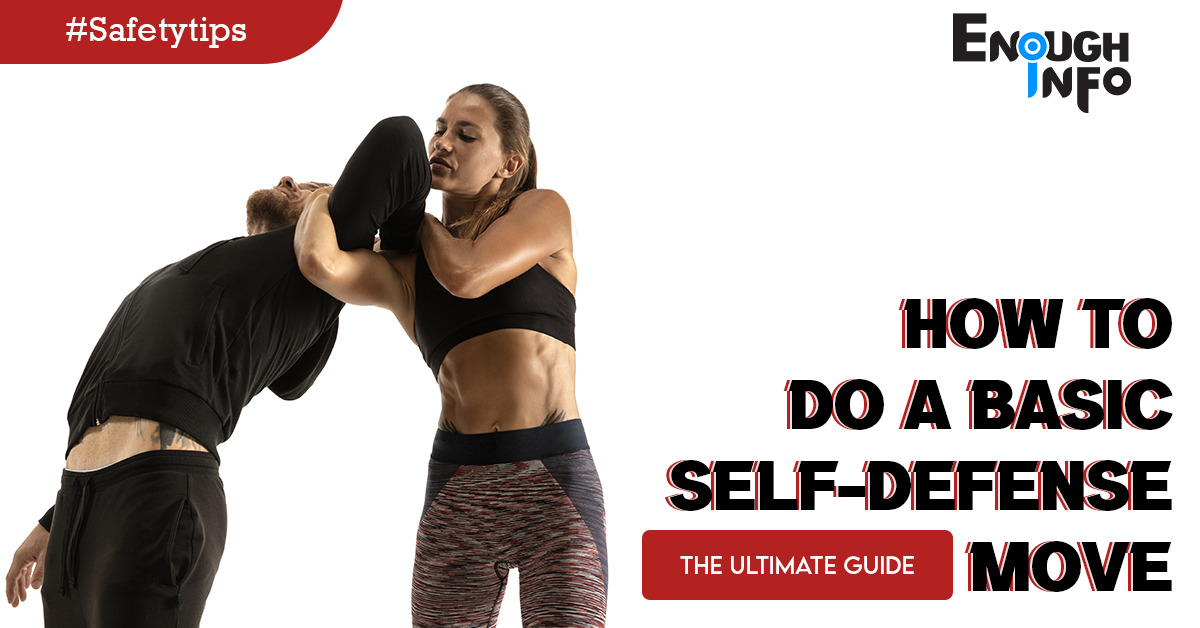How To Do A Basic Self-Defense Move

How To Do A Basic Self-Defense Move: In an unpredictable world, personal safety is a priority. Learning basic self-defense moves equips individuals with the tools and knowledge to protect themselves in potentially dangerous situations. Whether you’re a seasoned martial artist or a complete beginner, understanding and practicing basic self-defense moves can significantly enhance your ability to stay safe. EnoughInfo.com

Learning how to do a basic self-defense move is important for personal safety, empowerment, awareness, and effective response in potentially dangerous situations. It builds a foundation for further self-defense training, instills confidence in daily life, promotes assertiveness and boundaries, prepares you for unexpected situations, contributes to community safety, and equips you with lifelong skills.
Read Also: How to protect yourself from sexual violence (Top 15 Tips)
FAQs & Answers on How To Do A Basic Self-Defense Move
1. How long does it take to learn basic self-defense moves effectively?
The time required to learn basic self-defense moves depends on various factors, including your commitment to practice, your physical abilities, and the complexity of the techniques. Consistent training and repetition are key to mastery, but even a few sessions can provide you with valuable skills to defend yourself.
2. Do I need to be physically fit to perform self-defense moves?
While being physically fit can enhance your overall ability to perform self-defense moves, anyone can learn and execute basic techniques with proper training and practice. Self-defense techniques are designed to utilize leverage, technique, and strategy, allowing individuals of varying fitness levels to protect themselves effectively.
3. Can self-defense moves be dangerous if not executed correctly?
Like any physical activity, there is a potential for injury if self-defense moves are not performed correctly. It is crucial to learn from a qualified instructor who can guide you in proper form and technique to minimize the risk of injury during training or real-life encounters.
4. Should I focus on striking or non-striking self-defense moves?
Striking and non-striking self-defense moves both have their merits and applications. Striking techniques, such as the palm strike, can be powerful and effective, but non-striking techniques, like escapes Striking techniques, such as the palm strike, can be powerful and effective, but non-striking techniques, like escapes and joint locks, are equally important. The choice between striking and non-striking moves depends on the situation, your comfort level, and the level of force necessary to neutralize the threat. It is recommended to learn a combination of both striking and non-striking techniques to have a well-rounded skill set.
5. Can I use self-defense moves against multiple attackers?
Defending against multiple attackers is challenging and should be approached with caution. It is important to prioritize your safety and focus on creating opportunities to escape rather than engaging in a prolonged fight. When facing multiple attackers, try to maintain situational awareness, use your environment to your advantage, and employ techniques that allow you to create distance and escape.
6. Are self-defense moves effective against armed attackers?
Self-defense moves can be effective against armed attackers, but it is crucial to remember that the priority should be to protect yourself and escape rather than engaging in direct confrontation. If faced with an armed attacker, look for opportunities to create distance and find cover while being aware of potential escape routes. Depending on the situation, it may be more appropriate to comply with the assailant’s demands to minimize harm.
7. Can self-defense moves work for people of all ages and physical abilities?
Yes, self-defense moves can be adapted to suit individuals of all ages and physical abilities. The key is to focus on techniques that utilize leverage, timing, and strategy rather than relying solely on physical strength. Training programs are often designed to accommodate participants of various fitness levels and provide alternative options for those with physical limitations.
8. Is it necessary to continue practicing self-defense moves once learned?
Yes, regular practice is crucial to maintain and improve your self-defense skills. Like any physical skill, consistency is key. By practicing self-defense moves regularly, you reinforce muscle memory, improve your reflexes, and increase your confidence in executing techniques effectively.
Read Also: How to Stay Fit at Home
9. Can self-defense training increase my confidence in everyday life?
Absolutely! Learning self-defense moves not only equips you with physical skills but also enhances your confidence and self-assurance. The knowledge that you can protect yourself if needed translates into a greater sense of personal safety and security, allowing you to navigate daily life with increased confidence.
Understanding how to do a basic self-defense move is crucial for several reasons:
1. Personal Safety:
In an unpredictable world, knowing how to protect yourself is paramount. Basic self-defense moves to equip you with the skills and techniques necessary to defend against potential threats and ensure your personal safety.
2. Empowerment
Learning self-defense moves instills a sense of empowerment and confidence. By acquiring the knowledge and ability to protect yourself, you become less vulnerable and more self-assured in various situations.
3. Prevention and Awareness
Self-defense training goes beyond physical techniques. It also teaches you to be proactive and aware of your surroundings. Developing situational awareness allows you to identify potential threats and take steps to prevent dangerous situations from escalating.
4. Effective Response
In the event of an attack or physical confrontation, knowing basic self-defense moves enables you to respond effectively. By understanding the mechanics of strikes, blocks, and escapes, you can quickly and decisively defend yourself, potentially minimizing harm and ensuring a safer outcome.
5. Building a Strong Foundation
Basic self-defense moves serve as the foundation for more advanced techniques. Mastering these fundamentals is crucial before progressing to more complex self-defense strategies or martial arts training. By building a strong foundation, you can enhance your overall self-defense capabilities.
6. Confidence in Daily Life
Learning self-defense moves not only provides physical skills but also boosts your confidence in everyday life. When you feel capable of defending yourself, you project a more confident demeanor, which can deter potential attackers and help you navigate various situations with greater assurance.
7. Personal Boundaries and Assertiveness
Self-defense training often emphasizes assertiveness and setting personal boundaries. Through effective verbal communication and body language, you can assert yourself, establish boundaries, and potentially de-escalate confrontations without resorting to physical force.
Read Also: How To Set Boundaries With People
8. Preparedness for Unexpected Situations
Life can throw unexpected challenges our way. Knowing how to do a basic self-defense move prepares you to handle unforeseen situations, whether it’s encountering a potential assailant or coming across a dangerous situation. This preparedness can make a significant difference in your safety and the safety of those around you.
9. Promoting a Safer Community
When more individuals possess basic self-defense skills, it contributes to a safer community as a whole. People who are trained in self-defense are better equipped to protect themselves, potentially deterring criminals and reducing instances of victimization.
10. Lifelong Skill
Self-defense is a skill that stays with you for life. Once you learn the basics, you can continue to practice and refine your techniques. This ongoing training not only maintains your proficiency but also reinforces muscle memory, reflexes, and overall physical fitness.
Mastering Basic Self-Defense Moves: Empowering Yourself with Essential Skills

In this comprehensive guide, we will explore step-by-step instructions for a basic self-defense move and provide valuable tips to help you master this essential skill.
The Importance of Self-Defense:
Before delving into the specifics of self-defense moves, it’s crucial to understand why learning these skills is essential. Self-defense empowers individuals to take control of their personal safety and well-being. By equipping yourself with self-defense techniques, you gain confidence, situational awareness, and the ability to protect yourself and others from potential harm. Self-defense is not just about physical combat; it encompasses mental preparedness, risk assessment, and effective communication to prevent or defuse dangerous situations.
Basic Self-Defense Move: The Palm Strike
The palm strike is a highly effective and versatile self-defense move that can be employed in various situations. It utilizes the heel of your palm as a striking surface to target an assailant’s vulnerable areas, such as the nose, chin, or throat. Here’s a step-by-step breakdown of how to execute a palm strike correctly:
Step 1: Assume a Defensive Stance
Start by positioning your feet shoulder-width apart, ensuring stability and balance. Bend your knees slightly, keeping your weight centered between both legs. Distribute your weight evenly to maintain stability throughout the move.
Step 2: Identify the Target
Identify the assailant’s vulnerable areas that you can target with your palm strike. Common targets include the nose, chin, or throat. Visualize these targets to enhance your focus and aim.
Step 3: Form a Proper Hand Position
Curl your fingers into a loose fist, keeping your thumb tucked securely alongside your fingers. This hand position prevents any accidental injury to your thumb during the strike. Ensure your palm remains firm and rigid, ready to deliver a forceful blow.
Read Also: How To Be A Man
Step 4: Generate Power
To generate maximum power for your palm strike, transfer your body weight to your back leg. As you prepare to strike, rotate your hips and shoulders in the direction of your target. This rotational movement will generate additional force behind your strike.
Step 5: Execute the Strike
Extend your arm fully, thrusting your palm forward toward the target area with explosive force. Aim to strike the target using the heel of your palm, as it is a solid and powerful striking surface. Make sure to maintain a straight wrist and avoid bending it upon impact to prevent injuries.
Step 6: Follow Through
After delivering the strike, quickly retract your arm back to the defensive position. Stay aware of your surroundings, reassess the situation, and be prepared for any further action that may be necessary.
Tips for Mastering Basic Self-Defense Moves:
- Practice Regularly: Consistency is key when learning self-defense moves. Dedicate regular time for practice to reinforce muscle memory and improve your technique.
- Focus on Fundamentals: Mastering the basics is essential before progressing to advanced techniques. Develop a strong foundation by perfecting the execution of basic self-defense moves.
- Seek Professional Instruction: Consider enrolling in a self-defense class or training program led by experienced instructors. They can provide expert guidance, correct any errors in your technique, and offer valuable insights.
- Train with Partners: Practice self-defense moves with a partner whenever possible. This allows you to simulate realistic scenarios and develop your skills in a controlled environment.
Enhance Your Fitness Level
Improving your overall fitness level can greatly benefit your self-defense skills. Engage in regular physical exercise to build strength, endurance, and flexibility. Cardiovascular workouts, weight training, and exercises that target core strength are particularly beneficial. A fit body will enable you to execute self-defense moves with more power, agility, and control.
Develop Situational Awareness
Self-defense is not solely about physical techniques; it also involves being aware of your surroundings. Practice maintaining a high level of situational awareness in various environments. Stay alert, observe your surroundings, and identify potential threats or escape routes. By being aware of your surroundings, you can often prevent dangerous situations from escalating.
Trust Your Instincts
Intuition plays a crucial role in self-defense. If a situation feels unsafe or suspicious, trust your instincts and take appropriate action. It’s better to err on the side of caution and remove yourself from a potentially dangerous situation.
Verbal Assertiveness
Effective communication can be a powerful tool in self-defense. Develop assertiveness in your verbal communication skills. Use a confident tone and clear language to establish boundaries, assert your rights, and deter potential attackers. Sometimes, verbal assertiveness alone can de-escalate a situation and avoid physical confrontation.
Practice Realistic Scenarios
To enhance your self-defense abilities, practice scenarios that mimic real-life situations. Simulate common attack scenarios with a training partner, considering factors like surprise attacks, varying distances, and different types of assailants. By training in realistic scenarios, you can better prepare yourself mentally and physically for potential threats.
Stay Calm under Pressure
Maintaining composure during a high-stress situation is crucial. Practice controlling your breathing and keeping a calm mindset when executing self-defense moves. Panic can cloud judgment and hinder your ability to respond effectively. By staying composed, you can think clearly and make sound decisions.
Read Also: How To Be Healthy And Active
Conclusion:
Learning basic self-defense moves is a valuable investment in your personal safety. The palm strike, a fundamental technique, allows you to deliver a forceful strike to an attacker’s vulnerable areas. Remember to practice regularly, seek professional instruction, and focus on the fundamentals. Additionally, enhance your fitness level, develop situational awareness, and trust your instincts. By following these guidelines and continually honing your skills, you can empower yourself with the ability to protect and defend yourself in potentially dangerous situations. Self-defense is not just about physical techniques; it encompasses mental preparedness, confidence, and proactive risk management. Stay vigilant, stay prepared, and prioritize your personal safety.
Recommended;
14 Cheap Ways to Block a Neighbors View (2023 Guide)
How To Protect Your Children From Child Abuse
Common Types Of Cyber Attacks And How To Protect Your Personal Data




